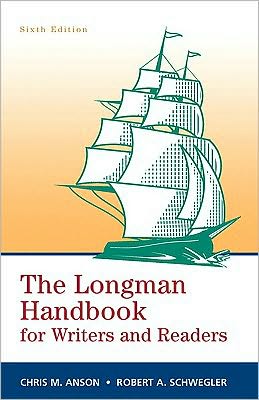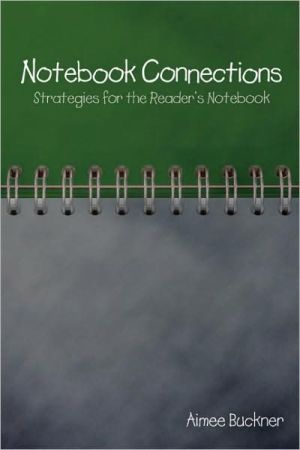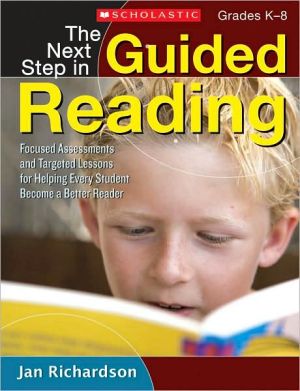Longman Handbook for Writers and Readers, The (paperbk)
The Longman Handbook for Writers and Readers, Sixth Edition, emphasizes writing for different audiences, explores the connection between reading and writing, and presents superior writing across the curriculum coverage while also providing all the handbook basics.\ A comprehensive reference to writing, research, documentation, and grammar, The Longman Handbook explores the differing audiences, purposes, and conventions of various communities of writers and readers, and offers students...
Search in google:
The Longman Handbook for Writers and Readers, Sixth Edition, emphasizes writing for different audiences, explores the connection between reading and writing, and presents superior writing across the curriculum coverage while also providing all the handbook basics.A comprehensive reference to writing, research, documentation, and grammar, The Longman Handbook explores the differing audiences, purposes, and conventions of various communities of writers and readers, and offers students concrete strategies for adapting their writing to meet varying rhetorical situations. While emphasizing the academic community, The Longman Handbook also explores the genres of writing that students can expect to find in public and workplace communities.
PART 1 WRITING FOR READERS1 Writers, Readers, and CommunitiesAcademic, public, and work communities1 Communities in action2 Choices and limitsIdentifying electronic communities2 Discovering and Planning Getting started1 Try informal writing2 Use listing3 Ask strategic questionsKeeping a writing/reading journal1 How to keep a reading and writing journal2 Thinking, writing, and discoveringStructuring ideas and information1 Draw a cluster2 Create a tree diagram3 Build a time sequence4 Create a problem-solution grid5 OutlinePlanning: Paper in progress3 Purpose, Thesis, and Audience Recognizing your purpose1 Identify the focus2 Define the purposeUsing purpose to guide your writing1 Rough out a purpose structureDefining a thesis or main idea1 Turn topics into theses2 Complicate or extend your rough thesis3 Expand your thesis with specifics4 Modify your thesisDifferent kinds of thesis statementsRecognizing your audienceSpecific readers and communities of readersAdapting to readers and communities of readers4 Drafting From planning to drafting1 Draft in manageable parts2 Develop a general structure3 Assess your purpose and redraftDrafting strategies1 Write about your writing2 Draft quickly3 Semidraft4 Talk it out or take a breakCollaborative drafting1 Do parallel drafting2 Do team drafting3 Do intensive drafting5 Revising, Editing, and Proofreading Major revisions1 Redraft unworkable material2 Reorganize poorly arranged paragraphs or sections3 Add new material4 Delete unnecessary or redundant materialMinor revisions1 Revise for sense2 Revise for style3 Revise for economyCollaborative revising1 Respond helpfully2 Make the most of response3 Workplace collaborationRevising: Paper in progressEditing your own writing1 Final editing for economy and style2 Editing for grammatical problemsCollaborative editingEditing on the computer1 What computer editors can do2 What computer editor can’t doProofreading6 Paragraphs Focused paragraphsCreating paragraph focus1 Topic sentence at the beginning2 Topic sentence plus a limiting or clarifying sentence3 Topic sentence at the end4 Topic sentence implied rather than statedParagraph coherenceCreating paragraph coherence1 Repeating words and phrases2 Supplying transitions3 Using parallel structureDeveloped paragraphs1 Developing paragraphs with details2 Creating paragraph structuresIntroductory and concluding paragraphs1 Creating introductory paragraphs2 Creating concluding paragraphs7 Sentences Clear sentences1 Use significant subjects2 Avoid unnecessary nominalizations3 Use I, we, and you as subjects4 Be careful with strings of nouns5 Use clear and specific verbs6 Keep subjects and verbs clearly relatedDirect sentencesEmphatic sentences1 Use sentence beginnings and endings2 Create emphatic sentence patterns3 Use the passive voice with careRevising for variety1 Vary sentence length2 Vary sentence types3 Vary sentence structure and patterns4 Create surprise8 Assessing WritingAssessing your own writing1 Saying what you want to say2 Sharing what you want to share3 Being honest about things that didn’t work or shortcuts you took4 Recognizing what you didn’t understand5 Deciding on a revision planAssessing someone else’s writing1 Deciding what makes a difference for you as a reader2 Believing and doubting3 Prompting change4 Working with othersHow others assess your writing1 Where readers start evaluating2 How readers move through your writing3 How readers decide on evaluation standardsAssembling and assessing your portfolio1 Choosing the best2 Choosing and assessing for variety3 Introducing and explaining your selectionsPART 2 CRITICAL THINKING AND ARGUMENT9 Thinking Critically and Reading CriticallyWhat is critical thinking?Building a chain of reasoning1 Focus on conclusions2 Include information and inferences3 Assess evidence and reasoning4 Consider your readers’ assumptionsPersuasive reasoning1 Be well informed2 Acknowledge other perspectives and anticipate reader’s reactions3 Be balanced and reasonable4 Assess the appropriateness of strong bias to the occasionWhat is critical reading?Read to understand1 Prereading strategies2 Reading strategies during and afterRead to respond and evaluate1 Note responses while reading2 Share interpretations and insights3 Respond in writing10 Constructing an Argument Occasions for argument1 Existing issues2 Potential issues3 Identify arguable issuesDeveloping your stance1 Articulate your stance2 Clarify your ideasDeveloping a thesis1 Focus on an argumentative claim2 Create a thesis statement3 Revise your thesis statement11 Developing, Supporting, and Documenting an ArgumentDeveloping reasons that support your claimUsing varied kinds of evidence1 Use examples2 Use quotations and ideas from authorities3 Use detailed information4 Use comparisonsIncorporating counterargumentsLogical strategies (logos)Emotional strategies (pathos)Data-warrant-claim (Toulmin) reasoningAudience and purpose (Rogerian argument)Misleading and illogical reasoningDocumented argument or position paper1 Sample position paper2 Comment on Paul Pusateri’s Paper12 Creating a Visual ArgumentExplaining1 Calling attention to an issue2 Explaining an issue or problemProviding evidenceReading images criticallyMultimodal materialsPART 3 PRESENTING YOUR WORK13 Designing DocumentsGoals of document designFormat choice1 Consider your rhetorical situation and readers’ needs2 Determine the form and shape of your documentLayout1 Use visual cues2 Arrange information effectivelyTypeface choicesVisuals1 Table organize information2 Graphs and charts represent relationships among data3 Other visual devices serve varied purposesWeb pages1 Establishing a purpose and a persona for your Web page2 Considering your audienceModel documents14 Multimodal PresentationsMultimodal compositions1 Photographs2 Advertisements3 Videos4 Oral presentationsAnalyzing multimodal presentations1 Purpose and focus2 Detail and explanation3 DesignComposing multimodal presentations1 Developing your craft2 Computer softwareEvaluating multimodal presentations15 Writing OnlineOnline writing1 Understanding your online audience and your purpose2 Creating an online persona3 NetiquetteAvoiding plagiarism and acting ethically online1 Always document or credit information borrowed from others2 Do your own work3 Know the rulesE-mail choices1 Elements of email2 Email appearance3 Using the functions of emailParticipating in online communities1 Discussion lists2 Web-based forums: Blogs3 Real-time writingParticipating in virtual classrooms1 Using electronic courseware2 Taking courses online16 Speaking EffectivelyEffective oral presentation1 Planning your presentation2 Rehearsing your presentation3 Giving your presentationSAMPLE POWERPOINT PRESENTATION4 Assessing the resultsSpeech AnxietyGroup presentations and other public forums1 Effective group presentations2 Effective speaking in public forums3 Effective comments on boards and committeesPART 4 WRITING FOR SPECIFIC COMMUNITIES17 Academic Writing: General EducationAnalyzing assignments1 Syllabus assignments2 Detailed assignments3 Assignment goalsCommon types of information-driven assignmentsSummariesAnnotated bibliographiesLiterature reviewsEssay exams (information-driven)1 Sample information-driven essay exam2 Commentary on student essay examShort documented paperCommon types of point-driven assignmentsCritiquesReviewsEssay exams (point-driven)Position papers18 Writing in the Arts and HumanitiesWriting about textsReading literary and artistic texts1 Reading for meaning2 Reading for techniqueWriting about literary and artistic texts1 Writing about meaning2 Writing about techniqueThe text analysis1 Sample literary text analysis2 Commentary on student text analysisAnalyzing and interpreting visual texts1 Sample visual analysis2 Commentary on student visual analysisReviews and critical analyses (critiques) in the arts and humanities1 Sample critical analysis of a film2 Commentary on student analysis19 Writing in the Social and Natural SciencesResearch in the social sciencesCommon types of writing assignments in social science coursesReviews of research1 Sample social science literature review2 Commentary on student literature reviewInformative reportsReports of original researchResearch in the natural and applied sciencesCommon types of writing assignments in natural and applied science coursesLab reports1 Sample lab report2 Commentary on student lab reportAbstractsInformative reportsScientific explanation for a general audience1 Sample scientific explanation for a general audience2 Commentary on student scientific explanation for a general audience20 Public WritingGoals of public writingAnalyzing public audiencesTypes of public writingFlyersLetters to the editorSpeaking in public settings21 Workplace WritingGoals of workplace writing1 Plan according to your reader’s needs2 Draft as clearly as possible3 Revise and editWorkplace writing process1 How are writing projects assigned?2 Is most writing done individually, or in work groups?3 Does the company have a formal editing process?4 Does the company have a formalized set of writing genres?5 How are revisions to documents such as work procedures and technical specifications controlled?Business lettersMemosEmailRésumés and application letters1 Use categories to construct your résumé2 Submitting your résuméPART 5 RESEARCHING AND WRITING22 Getting Started: Researching and WritingChoosing a topic1 Respond to your assignment2 Recognize your interests3 Browse for an issue or problemNarrowing a topic1 Broad subject to limited topic2 Surveying potential topicsAims of research writing1 Informative research project2 Persuasive research projectResearch questionsPreliminary thesisAudience inventoryDeveloping a search strategy1 Resources2 Search tools3 Keywording4 Working bibliographyTimelineAssessing sourcesReading sources critically1 Identifying questionsTaking notes1 Cards2 Research journalSummarizing, paraphrasing, synthesizing, and interpreting1 Summarizing2 Paraphrasing3 Synthesizing4 Interpreting23 Library ResourcesFrom general to specific sources1 General resourcesKinds of library resources1 Online catalogs2 Periodicals, print and electronic indexes, and government documentsEvaluating library resources24 DatabasesReference databasesFull-text databasesDatabases containing abstractsIndexing or bibliographic databasesResource databasesEvaluating database resources25 Internet ResourcesInternet search strategySearch engines1 General search engines2 Advanced search engines3 Metasearch engines4 Focused search sites and question-oriented sitesKinds of Web sites1 Individual Web sites2 Sponsored Web sites3 Blogs4 Online periodicals and books; electronic versions of print publications5 Government publications sites6 Discussion groups and newsgroupsEvaluating online resources26 Field Resources and FieldworkField researchSurveys, polls, and questionnaires1 Surveys and polls2 QuestionnairesInterviewsObtaining human subjects’ consent and approvalEthnographies27 Avoiding Plagiarism and Integrating SourcesPlagiarism in collegeThe problem of intentionWhen to document sourcesCommon knowledgeQuotations, summaries, facts, and visuals1 Quotations2 Summaries and paraphrases3 Facts, details, and statistics4 VisualsIntegrating sources for specific purposes1 Introducing a topic and providing background2 Summarizing prior research3 Providing examples and cases4 Showing evidence or support5 Expanding an idea6 Taking issue with a claim28 Writing, Revising, and Presenting ResearchPlanning1 Think about your goal – again!2 Review your research questions3 Redevelop you thesisDraftingAn informative research paper1 Consider readers2 Look for a pattern3 Consider familiar plansA persuasive research paper1 Key elements2 Plan your reasoning and support3 Arrange statements and evidence in persuasive orderPresentation strategies1 Create a presentation2 Use photographs3 Create a film4 Design a Web pagePART 6 DOCUMENTING SOURCES 29 Ten Serious Documentation ProblemsChoosing the right documentation styleDeciding what to documentUnderstanding the importance of documentationFollowing a publication’s styleIncorrect placement of a citationMissing information in a citationWrong details in a citationWrong kind of entry in references listMissing information in references entryWrong details in references entry30 MLA DocumentationIn-text citation examplesWorks Cited listSample MLA paper31 APA DocumentationIn-text (parenthetical) citationsReferences listSample APA paper32 CMS DocumentationEndnotes and footnotes1 Select endnotes or footnotes2 Content and explanatory notesNote examplesBibliographyStudent CMS paper33 CSE Documentation Elements of scientific and engineering styles1 In-text citations2 Reference listScientific in-text citations1 Using the name-and-date method2 Using the number methodScientific reference listStudent CSE paperPART 7 GRAMMAR34 Ten Serious Grammar Errors FragmentFused SentenceUnclear Pronoun ReferenceLack of Subject-Verb AgreementDangling ModifierShiftMisused or Missing ApostropheUnnecessary CommaMissing or Misused Quotation MarksDouble Negative35 Sentence Elements and PatternsWords1 Recognizing nouns and articles2 Recognizing pronouns3 Recognizing verbs4 Recognizing adjectives5 Recognizing adverbs6 Recognizing prepositions7 Recognizing conjunctions8 Recognizing interjectionsSubjects and predicates1 Creating sentence subjects2 Creating sentence predicatesPhrases and clauses1 Recognizing prepositional phrases2 Recognizing absolute phrases3 Recognizing appositive phrases4 Recognizing verbal phrases5 Recognizing subordinate clausesSentence types1 Recognizing sentence structures2 Recognizing sentence purposes36 VerbsSimple present and past tense1 Watch for irregular verbs2 Using present and past tense in academic settingsParticiples: Recognizing and editingProgressive and perfect tenses: Editing1 Check the helping verb in progressive tenses2 Check the form of the past participle in the past perfect tenseTroublesome verbs (lie, lay, sit, set)Active and passive voiceClear tense sequenceSubjunctive mood37 Nouns and PronounsNoun formsPronoun forms1 Recognizing pronoun case2 Choosing subjunctive forms3 Choosing objective forms4 Choosing possessive formsCommon problems with pronouns1 Pay attention to compound subjects and objects2 Watch for we or us with a noun3 Be alert for subject complements4 Check appositives5 Be careful with comparisons using than or as6 Be cautious when using myself and other reflexive pronounsWho and whom38 AgreementSubject-verb agreement (simple)Subject-verb agreement (complex)1 What for plural forms with singular meanings2 Be alert for collective nouns3 Check subjects linked by and, or, and nor4 Pay attention to separated subjects and verbs5 Recognize unusual word order6 Watch for there is, there are7 Pay attention to is, appears, feels, and other linking verbs8 All, everybody, none; who, which, that – using special subjects9 Pay special attention to titles and namesPronoun-antecedent agreement1 Recognize antecedents joined by and, or, and nor2 Pay attention to everyone, any, something, (indefinite pronouns) as antecedents3 Watch for collective nouns as antecedents39 Adjectives and AdverbsWhat adjectives and adverbs doAvoiding confusion between adjectives and adverbs1 Figure out what a modifier does in a sentence2 Be alert for verbs like look, feel, prove, and is3 Pay special attention to real/really, sure/surely, bad/badly, and good/wellComparatives and superlatives: Correct forms1 Watch out for illogical comparatives2 Look for imprecise use of comparatives3 Check for double comparativesAvoiding double negativesPART 8 SENTENCE PROBLEMS40 Sentence FragmentsSentence fragments: Recognizing1 Look for a subject and a verb2 Look for although, because, that, since, and other subordinating words3 Look for troublesome constructionsSentence fragments: EditingPartial sentences41 Comma Splices and Fused SentencesComma splices and fused sentences: RecognizingComma splices and fused sentences: Editing1 Create separate sentences2 Join main clauses with a comma plus a coordinating conjunction3 Join main clauses with a semicolon4 Join main clauses with a semicolon plus a conjunctive adverb or transitional expression5 Subordinate one of the clauses6 Join the clauses with a colon42 Pronoun ReferenceUnclear pronoun reference: Recognizing and editing1 Watch for pronouns with several possible antecedents2 Pay attention to pronouns widely separated from their antecedents3 Create clear reference chainsNonspecific pronoun reference1 Use it, which, this, and that with care2 Look for it used in more than one sense3 Watch for antecedents that are implied rather than directly statedMatching who, which, and that to antecedents43 Misplaced, Dangling, and Disruptive ModifiersMisplaced modifiers: Recognizing and editing1 Pay attention to a modifier’s location2 Pay attention to only, simply, even, and other limiting modifiers3 Be alert for squinting modifiers4 Pay attention to clauses beginning with who, which, and that, or other subordinatorsDangling modifiers: Recognizing and editingDisruptive modifiers: Recognizing and editing1 Pay attention to separated subjects and verbs2 Pay attention to separations between verbs and objects (or complements)3 Be alert for split infinitives or verb phrasesUsing absolute phrases effectively44 ShiftsPerson and number1 Pay attention to shifts in person2 Pay attention to shifts in numberTense and mood1 Pay attention to shifts in tense2 Be alert for shifts in moodVoiceDirect and indirect quotation45 Mixed and Incomplete SentencesMixed sentences: Recognizing and editing1 Recognizing topic shifts2 Editing topic shifts3 Recognizing shifts in grammatical pattern4 Editing shifts in grammatical patternIncomplete sentences: Recognizing and editing1 Recognizing and avoiding incomplete or illogical comparisons2 Recognizing appropriate and inappropriate omissions46 ParallelismProblems with parallelism: Recognizing and editing1 Check for parallelism in a series2 Decide which words to repeat3 Pay attention to parallelism with paired sentence elementsCreating parallelism beyond the sentence1 Creating parallel sentence clusters2 Creating parallel paragraphsParallelism in lists47 Coordination and SubordinationCreating coordinationProblems with coordination: Recognizing and editing1 Look for excessive coordination2 Check for illogical coordinationCreating subordinationProblems with subordination: Recognizing and editing1 Be alert for illogical or unclear relationships2 Be careful with troublesome subordinators: as/while, and which, but that, and who3 Watch out for excessive subordinationPART 9 WORDS AND STYLE 48 Wordiness Common types of wordiness1 Eliminate empty words and phrases2 Edit wordy and repetitive sentencesClichés, generalizations and overblown language1 Omit clichés2 Edit overblown language3 Eliminate excessive writer’s commentary49 Style, the Dictionary, and VocabularyWord choice, readers’ needs, and writers’ purposes1 Adjust your diction to your readers’ needs2 Adjust your diction to your purpose3 Adjust your diction to your persona4 Use specialized diction appropriatelyPrecise diction1 Choose specific words2 Choose words with appropriate connotations3 Edit for archaic words and neologism4 Edit for idiomatic and trite expressionsUsing a dictionary and thesaurus1 Use a dictionary2 Use a thesaurusBuilding vocabulary1 Vocabulary and the writing process2 Vocabulary and the reading process50 Appropriate and Respectful Language Home and community language varieties1 Learn to see dialect variations as “rules”2 Understand standard English as a function of power and social prestige3 Become aware of the grammatical variations in your home dialectHow dialects influence writing1 Become aware of oral language influences2 Consider your word choices3 Distinguish between slang and dialect4 Recognize hypercorrectionSexist language: Recognizing and editing1 Avoid implying stereotyped views2 Avoid gender-stereotyping roles and occupations3 Beware of male terms used generically4 Avoid implying sexist views5 Avoid making unwarranted claimsDiscriminatory language: Recognizing and avoiding1 Avoid derogatory terms2 Revise unfair stereotypes3 Choose appropriate group names and termsPART 10 PUNCTUATION, MECHANICS, AND SPELLING51 CommasJoining sentencesSetting off introductory phrasesSetting off nonrestrictive modifiers1 Recognize nonrestrictive and restrictive modifiers2 Pay special attention to modifying clauses, phrases, and appositivesSetting off parenthetical expressionsUsing commas in a seriesSeparating coordinate adjectivesDates, numbers, addresses, place names, people’s titles, and letters1 Dates2 Numbers3 Addresses and place names4 People’s names and titles5 Salutations and closings of lettersCommas with quotationsCommas to make your meaning clearCommas that do not belong1 Do not insert a comma after words like although and because that introduce a clause2 Do not insert a comma between a subject and a predicate3 Do not overuse commas52 Semicolons and ColonsUsing semicolons1 Try joining two sentences with a semicolon2 Use a semicolon with words such as however, on the other hand3 Use a semicolon with deleted structures4 Use a semicolon with a complex seriesUsing colons1 Use a colon to introduce examples, statements, and lists2 Use a colon to introduce questions3 Use a colon to separate titles and subtitles4 Use a colon to join sentences5 Avoid overuse and misuse of colons53 ApostrophesMarking possession1 Add an apostrophe plus –s to mark possession in singular nouns2 Add an apostrophe to mark possession in plural nouns3 Add an apostrophe plus –s or an apostrophe to only the last word in a noun phraseMarking contractions and omissions1 Use an apostrophe to contract a verb form2 Use an apostrophe to mark plural letters3 Use an apostrophe to abbreviate a year4 Use an apostrophe to show colloquial pronunciation54 Quotation MarksMarking quotations1 Direct quotations2 Indirect quotations3 Quotations inside quotationsBlock quotationsDialogueTitles of short worksSpecial meanings of words and phrasesIrony, sarcasm, and authorial distance55 Periods, Question Marks, and Exclamation PointsPeriods1 End a sentence with a period2 Use periods in abbreviationsQuestion marks1 End a direct question with a question mark2 Watch for other uses of question marksExclamation points1 End an emphatic statement with an exclamation point2 Watch for other uses of exclamation points56 Special PunctuationParentheses1 Use parentheses to set off words or sentences2 Watch for special uses of parenthesesBrackets1 Use brackets for interpolations2 Use brackets within parenthesesDashes1 Use dashes for emphasis2 Avoid overuse of dashesEllipses1 Use ellipses in quotations with omitted words2 Use ellipses for other gapsSlashes1 Use slashes with alternative words2 Use slashes when quoting lines of poetry57 CapitalizationBeginning a sentence1 Capitalize the opening word in a quoted sentence2 Capitalize a freestanding sentence in parentheses3 Decide whether to capitalize following a colon4 Decide whether to capitalize elements in a series or listProper nouns and adjectives1 Capitalize proper nouns and adjectives2 Capitalize the pronoun I and the interjection OTitles of works58 Italics (Underlining)Following conventions1 Italicize titles of long or major works2 Italicize names of specific vehicles3 Italicize foreign words and phrases4 Italicize words, letters, and numbers named as wordsEmphasis59 Hyphens and Word DivisionDividing wordsJoining words1 Check hyphens in compound words2 Hyphenate familiar compounds correctly3 Hyphenate compound modifiers correctly4 Use hyphens to create new compounds60 NumbersSpelling out or using numerals1 Spell out number of one or two words2 Spell out number that begin a sentence3 Express related numbers in a consistent formSpecial conventions1 Use numerals when appropriate2 Spell out numbers when appropriateToo many numbers61 AbbreviationsFamiliar abbreviations1 Abbreviate titles with proper names2 Abbreviate references to people and organizations3 Abbreviate dates and numbers correctlyUsing abbreviations sparingly1 Avoid inappropriate abbreviations2 Limit Latin abbreviations62 SpellingSpelling and the computer1 Understand how spell checkers works2 Use a spell checker cautiouslyRecognizing and correcting spelling errors1 Pause to think2 Look it up3 Be alert for common patterns of misspelling4 Watch for commonly misspelled words5 Get helpLong-term strategies








